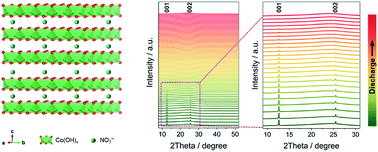Layered cobalt hydrotalcite as an advanced lithium-ion anode material with high capacity and rate capability†
Abstract
Lithium-ion anode materials with high energy density and high power density are growing in demand for practical applications. However, conventional electrode materials such as graphite and lithium titanium oxide (LTO) cannot meet these requirements. Here, we report layered cobalt hydrotalcite (LCH) as an advanced anode material for lithium-ion batteries with high capacity and rate capability. The large interlayer distance of the LCH structure offers sufficient space for lithium-ion insertion, which is demonstrated using various electrochemical analyses, operando X-ray diffraction, and ex situ X-ray photoelectron spectroscopy. Owing to the fast lithium-ion insertion kinetics and the unique 2D morphology, the LCH exhibits a high reversible capacity of 743.9 and 643.4 mA h g−1 at 500 and 2000 mA g−1 over 600 and 2000 cycles, respectively, and an outstanding rate capability (490.0 mA h g−1 at 5000 mA g−1) in lithium-ion half cells. This excellent electrochemical performance makes LCH a promising alternative to the currently existing pseudocapacitive materials as an anode for lithium-ion batteries.



 Please wait while we load your content...
Please wait while we load your content...